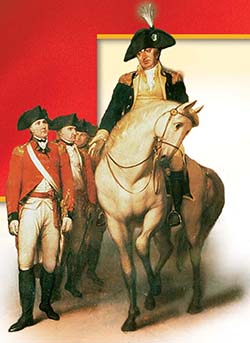SECTION 4: War’s End and Lasting Effects

Redcoats surrender at Yorktown ►
WITNESS HISTORY  AUDIO
AUDIO
Cornwallis Surrenders
More than 15 years after colonists began protesting new taxes, the Patriots defeated the British army.
“I have the Honor to inform Congress, that a Reduction of the British Army under the Command of Lord Cornwallis, is most happily effected. The unremitting Ardor which actuated every Officer and Soldier in the combined Army on this Occasion, has principally led to this Important Event, at an earlier period than my most sanguine Hopes had induced me to expect.”
—George Washington, October 19, 1781
Objectives
- Assess why the British failed to win the war in the South.
- Describe how the British were finally defeated.
- List the terms of the peace treaty.
- Explain how the war and the peace treaty affected minority groups and women.
- Assess the impact of the American Revolution on other countries.
Terms and People
- Kings Mountain
- Yorktown
- Treaty of Paris
- manumission
NoteTaking
Reading Skill: Recognize Sequence Use a flowchart to record the events leading up to the Treaty of Paris.

Why It Matters By eighteenth-century standards, the American Revolution was very radical. For the first time, overseas colonies rejected their empire to create a republican union—something long dismissed as a dangerous fantasy. By defying the conventional wisdom of their time, the Patriots began an enormous experiment aimed at creating a more open and equal society. Section Focus Question: What did the Revolution accomplish, and what ideas did it set in motion?
The British Invade the South
As the war continued, the British expected Loyalist support in the South, especially among the farmers of North Carolina, South Carolina, and Georgia. But the British wasted this support by continuing their misguided strategy. Instead of supporting Loyalist militias, the British continued to wage a conventional war.
The British Win Early Victories
In the South, as in the North, the British won most of the battles and captured the leading seaports. In late 1778, they seized Savannah, Georgia. During the spring of 1780, they captured Charleston, South Carolina—along with 5,000 Patriot soldiers. That summer, the British crushed another Patriot army at Camden, South Carolina.
Just as the British began their offensive in the South, Spanish forces under Bernardo de Gálvez made key attacks on British forts in the Gulf Coast region. In 1780, they captured the British fort at Mobile, Alabama. The next year, they took Pensacola, the capital of British




